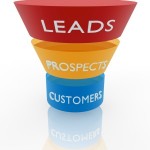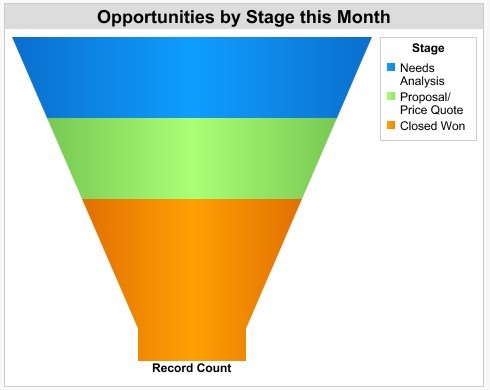A lack of qualified prospects moving through your sales process TODAY can mean trouble for your business  TOMORROW. Building a healthy sales pipeline is critical to attain your revenue goals 3, 6 or 9 months from now…
TOMORROW. Building a healthy sales pipeline is critical to attain your revenue goals 3, 6 or 9 months from now…
So what steps should you take to build and sustain a HEALTHY sales pipeline all year long?
- Start with ENOUGH Leads
We all know that sales is a numbers game. To develop a healthy sales pipeline, you must start with enough leads to crank through your marketing and sales engine. After all, only a portion will become “qualified leads,” and of those, only a fraction will be ready to buy at any given time.
So – it is PARAMOUNT that you add ENOUGH targeted leads into the top of your marketing and sales engine!
Do you honestly have enough leads to achieve ongoing sales success??
Are you using LinkedIn, or “referral based marketing” as your primary source of leads? If so, your sales pipeline probably looks dismal! How many suspects are in your lead pool today? 100? 300? That’s not nearly enough to create a healthy pipeline.
If the goal is to catch a lot of fish, you have to STOP POLE FISHING! It’s time you cast out a wider net!
To generate enough qualified leads to add to your sales pipeline on a regular basis, you must market regularly to a much larger database of targeted contacts…
- Qualify Every Lead
Next, assuming you have a marketing engine to generate interest, you must qualify each interested lead. After all, you don’t want a bunch of tire kickers clogging up your pipeline.
Generate a list of qualifying questions to ask every interested lead. Determine if there is a real business opportunity there or not, and assign a lead quality of A, B, or C to each lead.
Do they have a realistic need you can fill? Ask prospects:
- What are your major challenges in this area? What keeps you up at night?
- Have you tried to solve these issues? If so, how?
- How soon do you want to find a solution?
- What solutions would you consider?
- What is the budget to address the situation?
Use open-ended probing questions to determine the extent of their needs. Are their needs beyond the scope of your offering? If so, refer them to a partner resource. Do they appear to have little or no budget? Mark them as a “C” lead and move on to other prospects. Stay focused and know when to walk away.
Use Lead Quality for Targeted Marketing Purposes: Use the resulting lead quality data to develop more targeted marketing campaigns to boost results. For example, ‘A’ leads may receive more frequent or targeted email campaigns than ‘C’ leads.
- Nurture Qualified Prospects
Not every qualified prospect will be ready to buy today. Once you have identified “qualified prospects,” leverage the use of content-based email marketing to continue to nurture leads and identify interested prospects. Call to follow up with all email respondents within 48-72 hours!
You may want to make use of “lead-scoring,” available with most third party email marketing solutions. In lead-scoring, click-through leads are auto-assigned points as a result of clicking on certain links or pages, allowing you to more easily identify “hot” prospects. Be sure to call on the resulting “hot” leads within one business day.
Create a “Next Step” for EVERY interested lead. What is the best next step based on their need/interest/timing?
- Schedule a demo or follow up call to share additional insights?
- Send a follow-up email and add a tickler note to follow up in X time period?
- Send an industry-related article every 3-4 weeks to stay in touch?
Remain in front of interested, qualified prospects reguarly so that when that elusive time of need arises, you’ll be there to assist. ALWAYS schedule a next step. Continue to move each lead through the sales process to build your sales pipeline!
- CRM System & Your Sales Pipeline
Using an online customer relationship management (CRM) system is imperative to track all lead, prospect, and customer activity. (Still using an Excel spreadsheet? It’s time to upgrade!) In case you’re not familiar with CRM system set up, here are a few tips:
- Customize the CRM system to track lead quality (A/B/C)
- Map your organization’s sales process, then customize your CRM system to match that process:
- Qualification – 10%
- Needs Analysis – 35%
- Proposal – 75%
- Negotiation – 90%
- Closed Won – 100%
- Closed Lost – 0%
- Track every sales Opportunity in your CRM system.
- Graph results in a sales pipeline chart.
- Use this data to develop better sales forecasts and to inform business decisions.
A healthy sales pipeline will have the following attributes:
- A number of opportunities at every stage of the funnel
- A continuous flow of NEW opportunities coming into the top of the funnel every month
- NEW sales being generated at the bottom of the sales funnel every month!
It is helpful to visually gauge how the sales pipeline is shaping up – by rep, by product line, or as a company overall. Here is an example of a very basic sales pipeline chart with three simple opportunity stages:
Remember, there should be a number of opportunities at every stage, AND those opportunities must be moving THROUGH the pipeline stages for a pipeline to be considered healthy!
Circle tightly around each sales opportunity to move it down through the funnel to a closed opportunity. Review and update your sales pipeline DAILY. Identify and resolve any pipeline issues as early as possible.
- Is your pipeline top heavy with no opportunities in the last stages? If so, why?
- Is your pipeline bottom heavy? Why?
- Without enough opportunities entering the top of the funnel, you will have a revenue shortfall down the line.
- Identify & Move Stuck Opportunities
WHERE DO DEALS GET STUCK?
Identify stalled or stuck opportunities ASAP and find ways to move them forward to keep the pipeline healthy. If using a CRM system, run an opportunity aging report by stage. Dig into the data to discover trends. Provide additional sales training to resolve specific issues. What are the barriers to closing?
- Are there common points in the process where deals become lost or stuck? Why?
- Identify and resolve the root cause(s) of the “stuck” or “lost” opportunities, to reduce sales cycle time and move opportunities forward.
- Is an individual rep having trouble closing deals? Provide additional training as needed based on the following possible root causes:
- Is the contact an “influencer” and not a decision maker?
- Did the rep properly probe to uncover the prospect’s real needs?
- Did the prospect raise new objections at the time of closing?
- Should you institute an expiration date on all proposals to create urgency?
- Does your proposal inadvertently derail the sale?
Identify and rectify any areas of trouble in the sales cycle to keep the flow of qualified leads moving forward to closed deals!
In summary, if you take away only one thing from this article, it should be the critical FIRST STEP: YOU MUST market to enough targeted decision makers on a regular basis to build a healthy sales pipeline.
Isn’t it time you got serious about lead generation and pipeline building?
When you’re ready to cast a wider net to Corporate Training & HR decision makers in your TARGET MARKET, contact MTG. We have what you need.
Mentor Tech Group is the #1 resource for accessing decision makers in Corporate Training, e-Learning, HR, and Talent Management. With more than 40,000 CONFIRMED Training & HR decision maker contacts at 5500+ top US companies, there is no better resource to meet your pipeline growth needs.
For more information, or to request a quote, please CONTACT US TODAY: 651-457-8600, Ext. 1.
© Mentor Tech Group 2018. All Rights Reserved. Please email our offices for a Copyright Use policy.





